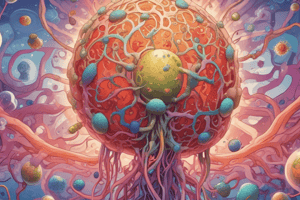Podcast
Questions and Answers
Which of the following categories do not belong to the main divisions of micro-organisms?
Which of the following categories do not belong to the main divisions of micro-organisms?
- Protozoa
- Fungi
- Insects (correct)
- Bacteria
What characteristic distinguishes eukaryotic cells from prokaryotic cells?
What characteristic distinguishes eukaryotic cells from prokaryotic cells?
- Always unicellular
- Complex structure and membrane-bound organelles (correct)
- Simple composition
- Presence of a nucleoid
Which of the following is NOT typically needed for microbial growth?
Which of the following is NOT typically needed for microbial growth?
- Appropriate temperature
- Hydration
- Sufficient nutrients
- High radiation levels (correct)
How are prokaryotic cells primarily characterized?
How are prokaryotic cells primarily characterized?
What role do microorganisms play in the human body?
What role do microorganisms play in the human body?
Which type of organism is classified as always unicellular?
Which type of organism is classified as always unicellular?
What is the primary focus of microbiology?
What is the primary focus of microbiology?
Which statement correctly describes a feature of eukaryotic organisms?
Which statement correctly describes a feature of eukaryotic organisms?
What is the primary factor influencing the establishment of the microbiome?
What is the primary factor influencing the establishment of the microbiome?
Which of the following is NOT a key feature of microbial enzymes?
Which of the following is NOT a key feature of microbial enzymes?
Which type of toxin is produced by bacteria and is characterized by high toxicity and the ability to elicit strong immune responses?
Which type of toxin is produced by bacteria and is characterized by high toxicity and the ability to elicit strong immune responses?
What role do metabolites play in dentistry, particularly related to Streptococcus mutans?
What role do metabolites play in dentistry, particularly related to Streptococcus mutans?
What aspect of microorganisms is crucial for their disease-causing potential?
What aspect of microorganisms is crucial for their disease-causing potential?
Which feature distinguishes endotoxins from exotoxins?
Which feature distinguishes endotoxins from exotoxins?
How do microbial enzymes assist in bacterial invasiveness?
How do microbial enzymes assist in bacterial invasiveness?
In what way does the microbiome change over time?
In what way does the microbiome change over time?
What is a key factor that affects microbial growth related to water availability?
What is a key factor that affects microbial growth related to water availability?
How does temperature affect bacterial growth according to the relevant graph?
How does temperature affect bacterial growth according to the relevant graph?
Which statement accurately describes the effect of light on parasitic micro-organisms?
Which statement accurately describes the effect of light on parasitic micro-organisms?
What basic nutrient requirements do microbes share with higher forms of life?
What basic nutrient requirements do microbes share with higher forms of life?
What role does nutrition play in microbial growth?
What role does nutrition play in microbial growth?
Which of the following statements about respiration in bacteria is correct?
Which of the following statements about respiration in bacteria is correct?
What is the effect of drying on different microbial species?
What is the effect of drying on different microbial species?
What is one effect of UV light on microorganisms?
What is one effect of UV light on microorganisms?
Flashcards are hidden until you start studying
Study Notes
Microbiology
- Study of organisms too small to be seen with the naked eye; 0.1-0.2mm diameter
- Known as micro-organisms or microbes
- Includes: bacteria, viruses, fungi, algae, and protozoa
Eukaryotes
- Large and complex
- Have a clearly defined nucleus
- Membrane bound organelles
- Single or multi-cellular
Prokaryotes
- Small and simple
- Have a nucleoid with no membrane
- Lacks internal membrane structure
- Always unicellular
Micro-organisms in Health
- Microbes support us in health
Establishment of Human Microbiome
- Microbial introduction and establishment of microbiome is a random process
- Influenced by factors including: mode of delivery, diet, age, geographical location, and lifestyle
Micro-organisms and Disease
- The disease potential of microbes is related to their products, antigenic nature, defences, and the host
- Disease potential is influenced by:
- Products: endotoxins, exotoxins, metabolites, enzymes
- Antigenic nature: ability to trigger immune response
- Defences: mechanisms for survival within the host
- The host: individual susceptibility and immune response
Microbial Enzymes
- Enzymes are catalysts bacteria use to break down materials or synthesize energy and building requirements
- Enzymes can produce changes in other substances without undergoing change themselves
- Microbial enzymes support invasiveness by:
- Allowing easy spread
- Providing protection
- Degrading host response
Environmental Microbial Growth Considerations
- Factors influencing microbial growth: temperature, pH, water, light, nutrition, and respiration
Temperature
- Most microbes grow best at specific temperature ranges:
- Psychrophiles: cold-loving microbes
- Mesophiles: moderate-temperature loving microbes
- Thermophiles: heat-loving microbes
- Hyperthermophiles: extreme heat-loving microbes
Moisture
- 80% of a microbial cell is water
- Drying is tolerated differently by different species
- Bacteria may not grow in dehydrated food, but growth may recommence once water is added
Light
- Parasitic micro-organisms grow and survive best in darkness
- UV light is lethal and used in some types of sterilization
- X-rays damage microbe DNA and can be used to sterilise medical supplies
Nutrition
- Basic requirements similar to higher forms of life: energy, nitrogen, carbon, water, and sulphur
- Different enzyme systems specific in breakdown of certain nutrient compounds
- Microbial growth can be enhanced by enriching the growth medium with specific nutrients and can be retarded using growth inhibitors
Studying That Suits You
Use AI to generate personalized quizzes and flashcards to suit your learning preferences.




